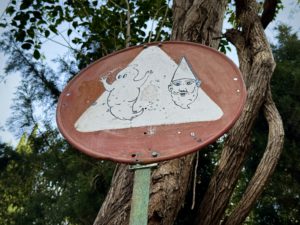February 15, 2024
By: Ferran Garcés
A common question from visitors is whether there is any ghost haunting Bellesguard. The Gothic appearance of the building, especially on rainy autumn and winter days, easily sparks the imagination. The answer is no. Perhaps due to the prohibition sign for gnomes and ghosts that the Guilera family left when they were owners.

Instead, what we do have are many, many legends. Gaudí, a great enthusiast of legends, infused his work with references to the estate’s past, a past filled with great characters and events throughout the history of Catalonia.
Fantastic Beasts
Firstly, both in the garden and inside the tower, various legendary animals are hidden. In recent articles, we have mentioned them. Specifically, we are talking about two dragons, a viper, a griffin, and a phoenix. They are not alone; they are accompanied by various heraldic animals such as fish, roosters, horses, and rampant lions. The dragons, logically, remind us of Saint George and the dragon, perhaps the most popular legend of all. The phoenix was one of the symbols of the Renaissance, the cultural movement of Gaudí’s time. The other animals seem to evoke the deceased who once inhabited the ancient castle of Bellesguard, like the lion, a possible reference to King Martí the Human, or events from the monarch’s ancestors, such as the victories of Roger de Llúria, the admiral who said, “no fish will dare to rise above the sea (Mediterranean) unless it carries the shield or sign of the King of Aragon on its tail” (1).
A Quartered Goat
The reign of Martí I the Human is full of legends. One of them speaks of the curious method that determined the choice of the location to build his castle. In those times, royal advisers wanted to know if the pure air of the Collserola mountain range could improve the quite ailing health of the monarch.
As they say, the experiment used consisted of quartering a goat and distributing the pieces of the animal along the mountain. After a few days, they found that the best-preserved piece had been buried here. The story, or legend, concludes by saying that the monarch himself, influenced by Bernat Metge, his chief adviser and, at the same time, a great writer, christened the new castle with the name Bellesguard, which, in Catalan, can mean both “Beautiful View” and “Good shelter.”
A Melancholic Lookout
They say that King Martí, from the lookout of his Bellesguard palace, gazed at the Mediterranean, which was the place where news from the territories conquered by his ancestors arrived (2). The balcony built by Gaudí, with large windows, on the east facade, evokes this lookout and the associated legend.
In mid-1409, with very little time difference, two galleys appeared on the infinite line of the sea. In the first, the sails were normal and brought good news: the victory in the battle of Sant Lluri in Sardinia, by Martí the Young, the only son of the monarch who had reached adulthood and, at that moment, the king of Sicily. In the second, the sails were white, and the monarch had a bad feeling. Hours later, the sailors informed him that this promising heir had died suddenly. The story continues with a wedding, celebrated in the midst of mourning for the unfortunate child’s funeral.
The Star of Venus, or the Virgin Mary
In the center of the main facade of Torre Bellesguard, there is a spectacular three-dimensional rosette called “the star of Venus,” representing an octagram or eight-pointed star. The symbol has been interpreted with multiple meanings. On the one hand, it would recall the marriage of King Martí the Human to Margarida de Prades, in a desperate attempt to provide a new heir to the crown after the death of Martí the Young. On the other hand, the octagram is also one of the attributes of the Virgin Mary and the eastern star that the Three Wise Men followed to the stable, where Mary gave birth to Jesus, a king of kings.
A Quartered Bandit
On the facade facing the rising sun, as we have already indicated, Gaudí built a magnificent balcony to evoke the legendary lookout from which King Martí gazed at the Mediterranean. Below the lookout is the door to the stables with a lintel in the shape of a femur.
To know the origin of such a peculiar decorative element, it is no longer necessary to travel back in time to the reign of Martí I but rather to advance to the eve of All Saints’ Day in 1633. That day Serrallonga, the famous Catalan bandit, fell into the hands of justice and was taken to Barcelona. On January 8 of the following year, after enduring torment, he was condemned to the gallows and…
Do you remember the goat we talked about above? Well, the bandit suffered the same fate, that is, his body was quartered. To serve as an exemplary punishment, each piece was exhibited in the different places where he had lived, among which, according to legend, includes the ruins of what had been the palace of King Martí. Consequently, the femur of the lintel would be a reference to such a morbid legend. In fact, the older neighbors of the neighborhood call Bellesguard “the castle of Serrallonga” (3).
In summary, it is better to have legends than ghosts because legends, unlike ghosts, always leave some trace of their passage, and behind all of them, there is always a part of truth. We look forward to telling it to you in person!
Notes
(1) The original phrase was: “no fish will dare to rise above the sea if it does not carry a shield or sign of the King of Aragon on its tail” (Chronicle of Bernat Desclot, Chapter CLXVI).
(2) At this point, a clarification must be made. In the Plaza del Rey, next to the Lieutenant’s Palace and the former Royal Major Palace, a watchtower was completed in 1555. It is named the Mirador del Rey Martí, but this monarch died in 1410; it can hardly correspond to his reign. It is possible that the name recalls an older tower, which, in turn, refers to the legend of the king contemplating the sea.
In any case, it seems that the lookout, or window, was in the Bellesguard palace. In a letter from Bernat Metge, his chief adviser, we read the facts as experienced by a firsthand witness. You will see that, instead of a lookout, he says “window.”
“Know that on Sunday, the 14th of this month, being in the house of Bellesguard and wishing very much to know news of our much-loved firstborn, the king of Sicily, and of his host, from the window of our room, we saw a galley coming from the east that reached the beach of Barcelona. And shortly after, Guillem Pujada was with us, who told us that the said galley came from Sardinia and brought good news, but he still did not know it” (Metge, Bernat (1950), Complete Works and selection of royal letters drafted by him, Editorial Seelecta, Barcelona, letter of July 22, 1409).
(3) A new clarification. In reality, different places dispute the honor of being the hideout of the bandit. More information: Ferran, Garcés (07/14/2023), “Did you know? Bellesguard BEFORE Gaudí. Part III: Lair and Academy”: Link




